-
(单词翻译:双击或拖选)

Part 1 History of Easter 复活节的由来
Easter is a festival of overwhelming joy. The joy that celebrates life. Or, rather, the victory of life over death. But does it have any historic background? Did life really overcome death? Most important, why Jesus is so remembered on Easter? And why those funny stuffs like eggs, and bunnies came to be mixed up with those ideas?Also who brought all those customs on the soil of America?
Easter, the principal festival of the Christian1 church year, celebrates the Resurrection of Jesus Christ on the third day after his Crucifixion. The origins of Easter date to the beginnings of Christianity, and it is probably the oldest Christian observance after the Sabbath which was originally observed on Saturday, later on Sunday.
Meanwhile, many of the cultural historians find, in the celebration of Easter, a convergence of the three traditions - Pagan, Hebrew and Christian. According to St. Bede, an English historian of the early 8th century, Easter owes its origin to the old Teutonic mythology2. It was derived3 from the name Eostre, the Anglo-Saxon goddess of spring, to whom the month of April was dedicated4. The festival of Eostre was celebrated5 at the vernal equinox, when the day and night gets an equal share of the day.
The English name "Easter" is much newer. When the early English Christians6 wanted others to accept Christianity, they decided7 to use the name Easter for this holiday so that it would match the name of the old spring celebration. This made it more comfortable for other people to accept Christianity.
But it is pointed8 out by some that the Easter festival, as celebrated today, is related with the Hebrew tradition, the Jewish Passover. This is being celebrated during Nisan, the first month of the Hebrew lunar year. The Jewish Passover under Moses commemorates9 Israel's deliverance from about 300 years of bondage10 in Egypt.
It was during this Passover in 30 AD Christ was crucified under the order of the Roman governor Pontius Pilate as then the Jewish high priests accused Jesus of "blasphemy11". The resurrection came three days later, on the Easter Sunday. The early Christians, many of them being brought up in Jewish tradition regarded Easter as a new feature of the Pascha (Passover).
It was observed in memory of the advent12 of the Messiah, as foretold13 by the prophets. And it is equanimous14 with the proclamation of the resurrection. Thus the early Christian Passover turned out to be a unitive celebration in memory of the passion-death-resurrection of Jesus. However, by the 4th century, Good Friday came to be observed as a separate occasion. And the Pascha Sunday had been devoted15 exclusively to the honor of the glorious resurrection.
Throughout the Christendom the Sunday of Pascha had become a holiday to honor Christ. At the same time many of the pagan spring rites16 came to be a part of its celebration. Maybe it was the increasing number of new converts who could not totally break free of the influence of pagan culture of their forefathers17.
But despite all the influence there was an important shift in the spirit. No more glorification18 of the physical return of the Sun God. Instead the emphasis was shifted to the Sun of Righteousness who had won banishing19 the horrors of death for ever.
The Feast of Easter was well established by the second century. But there had been dispute over the exact date of the Easter observance between the Eastern and Western Churches. The East wanted to have it on a weekday because early Christians observed Passover every year on the 14th of Nisan, the month based on the lunar calendar. But, the West wanted that Easter should always be a Sunday regardless of the date.
To solve this problem the emperor Constantine called the Council of Nicaea in 325. The question of the date of Easter was one of its main concerns. The council decided that Easter should fall on Sunday following the first full moon after the vernal equinox. But fixing up the date of the Equinox was still a problem. The Alexandrians, noted20 for their rich knowledge in astronomical21 calculations were given the task. And March 21 was made out to be the perfect date for spring equinox.
The dating of Easter today follows the same. Accordingly, churches in the West observe it on the first day of the full moon that occurs on or following the Spring equinox on March 21, it became a movable feast between March 21 and April 25.
Still some churches in the East observe Easter according to the date of the Passover festival. The preparation takes off as early as on the Ash Wednesday from which the period of penitence22 in the Lent begins. The Lent and the Holy week end on the Easter Sunday, the day of resurrection.
Today, with all its joyous23 customs, Easter is indeed a major popular festival across the United States. A festival that has become more of secular24 in spirit, though it has religious background. 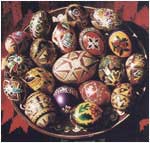
However, this was not the case all along the history of United States. Easter did not enjoy the status of a popular festival among the early settlers in America. Because most of them were Puritans or members of Protestant Churches who had little use for the ceremonies of any religious festivals. Even the Puritans in Massachusetts tried their best to play down the celebration of Easter as far as possible. While various rites are said to be associated with the celebration of Easter, most of them have come as part of the ancient spring rites in the Northern hemisphere.
Not until the period of the Civil War did the message and meaning of Easter begin to be expressed as it had been in Europe. It was the initiative of the Presbyterians. The scars of death and destruction which led people back to the Easter season. They found the story of resurrection as a great source of inspiration and renewed hope.Since then, of course, its joyous customs delight children and adults alike.
复活节是最古老最有意义的基督教节日之一。它庆祝的是耶稣基督的复活,世界各地的基督徒每年举行庆祝。复活节还象征重生和希望。早年在基督教会中对复活节的日期曾经有过争议,引起一时的混乱,直到公元325年,教士会议才决定整个教会统一在一天庆祝复活节。
复活节是基督教纪念耶稣复活的节日。传说耶稣被钉死在十字架上,死后第三天复活升天。每年在教堂庆祝的复活节指的是春分月圆后的第一个星期日,如果月圆那天刚好是星期天,复活节则推迟一星期。因而复活节可能在从3月21日到4月25日之间的任何一天。
典型的复活节礼物跟春天和再生有关系:鸡蛋、小鸡、小兔子、鲜花,特别是百合花这一季节的象征。 复活节前夕,孩子们会把鸡蛋着色打扮一番。这些蛋有的煮得很老,有的只是空空的蛋壳。复活节那天早上,孩子们会发现床前的复活节篮子里装满了巧克力彩蛋、复活节小兔子、有绒毛的小鸡及娃娃玩具等。据说复活节兔子会把彩蛋藏在室内或是草地里让孩子们去寻找。一年一度的美国白宫滚彩蛋活动经常被电视台实况转播。
复活节也是向你所关怀的人送鲜花、盆景、胸花等的节日。许多去做礼拜的人这天也向教堂献上花束。成人们则往往互赠贺卡或小件礼品。 传统上人们在复活节给孩子们送去活的小鸡、小鸭、小兔子等,但孩子们太小往往不能恰当地喂养这些小动物,所以究竟送什么礼物你得认真考虑一番。
Part 2 The Icons25 of Easter 复活节的象征
Egg, Bunny, and Lily, needless to say what they are for. These have become associated with Easter in such a manner that we can hardly get rid of them from our Easter functions, from deco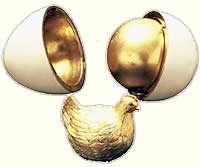 ration to fun, from confectionery to meal, from rites to rhymes, they are everywhere during the Easter.
ration to fun, from confectionery to meal, from rites to rhymes, they are everywhere during the Easter.
The Easter Egg 复活节彩蛋
Eggs and Easter have almost become synonymous. But what is so special in an egg? It is the influence of the traditional spring rites that made Easter so egg-special. And myths coming down to us from an incredibly distant past have shown man's relationship with the egg to be very deep seated one. This is caught in old Latin proverb: Omne vivum ex ovo. This means "all life comes from an egg". Not just the Latin saying, eggs are just laid well over all corners of the world. From ancient India to Polynesia, from Iran, Greece, and Phonecia to Latvia, Estonia, and Finland, from Central America to the west coast of South America, there are reports of myths of the whole universe created out of an egg.
So, it is not unusual that in almost all ancient cultures eggs had been held as an emblem26 of life.In Europe an egg was hung on New Year trees, on Maypoles, and on St. John's trees in midsummer. Indeed, all meant egg as a symbol of the regenerative forces of nature. Later during the Christian period, it was believed that eggs laid on Good Friday, if kept for a hundred years, would have their yolks turn to diamond. If Good Friday eggs were cooked on Easter they would promote the fertility of the trees and crops and protect against sudden deaths. And, if you would find two yolks in an Easter egg, be sure, you're going to be rich soon. That's what they believed!
Eggs were said to be dyed and eaten at the spring festivals in ancient Egypt, Persia, Greece, and Rome. The Persians of that time gave eggs as gifts at the vernal equinox. But it is not very clear how those colored eggs have come in to dominate the Easter basket. In fact, they have become so popular with the Easter celebration that they even started to dominate the ancient concepts of the symbolism of eggs. It is speculated that it was introduced in Europe, or, rather Western Europe, during the course of the fifteenth century. This was when missionaries27 or knights28 of the Crusades are thought to have brought in the concept of the coloring of eggs westwards.
In medieval times there was a superstition29: the church bells which had not been heard since Holy Thursday had been to Rome for the Pope's blessings30 and returned on Easter Eve with colored eggs for everyone. Many of the eggs were dyed red. Red was in memory joyous Easter celebration. Or it was to honor the blood that Christ shed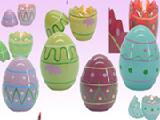 . During the strict Lenten fast of forty days no eggs were eaten.
. During the strict Lenten fast of forty days no eggs were eaten.
蛋象征春天新生命的开始,更象征耶稣复活走出石墓。其实四旬节守斋是禁止吃蛋的,到了十二世纪,才开始有鸡蛋的祝圣。
教徒习惯把蛋涂成红色,请神父祝圣,然后蛋送给朋友作为礼物。祝圣蛋的经文是祈求上帝使之成为健康的食品,并为庆祝耶稣的复活、怀着感激之情去食用。这是便是复活蛋的起源。
The Easter Bunny 复活节兔子
The bountiful Easter bunnies have become the most favorite Easter symbol. It's universal and secular in its appeal. And, most important of all, it relates to Easter historically. 
However, one fact has got to be made clear. It is the hare, and not the rabbit, that should be treated as the true symbol of Easter. Though both of them belong to the 'Lagomorpha' family and have most of things in common, there are some differences.
If you go by the history, since the ancient times the hare has been a symbol for the moon. Not the rabbit. And the legend says, the hare never closes its eyes, not even for a single blink!
The reason for having such a belief may be rooted in the fact that hares, not rabbits, are born with eyes open. Rabbits are born blind.
The ancient Egyptians related hares to the moon. Egyptian name for hare was 'un', meaning 'open'. And they were beloved to be watching the full moon opened eyes throughout the night.
And this fertility factor may hold the key in making rabbit more familiar as Easter symbol in America, as against the traditional hare. Rabbits beat hares by being more prolific31. The German immigrants, who brought in most of the Teutonic Easter traditions here, made rabbits so p opular among the non-German kids.
opular among the non-German kids.
The German children used to have rabbit's nests filled with decorated eggs. They also used to build nests. They looked so attractive that even the non-German kids demanded such gifts on the Easter.
依据欧洲古老的传说,野兔是一种终日不闭眼的动物,它们能在黑夜里观看四周其它的动物。因此,野兔代表着那黑夜中一轮皎洁的明月。
再加上计算复活节是以春天月圆为基准,于是就将春天繁殖力强的野兔视为复活节的象征。
The Lovely Lily of Easter 复活节百合
Who doesn't love to have the nice white lily as part of the Easter gift? In fact, the lovely white trumpet32 lily has been enjoying a great favor in being included as a principal item for church decoration for quite some time. A perfect gift of nature to beautify our Easter. Isn't it?
But its acceptance in America, as such, dates back around the 1800s. It came in with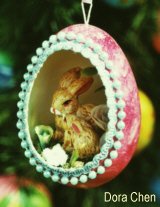 the rise in the Easter observances by the Protestants in America. And, strange, it took some more time to find a widespread acceptance. For, the early Americans those days were not used to seeing a lily waiting to be picked up for the Easter decor.
the rise in the Easter observances by the Protestants in America. And, strange, it took some more time to find a widespread acceptance. For, the early Americans those days were not used to seeing a lily waiting to be picked up for the Easter decor.
The native American lilies, for example, the garden or, Madonna lily, bloom in the early summer. Though it could be forced to bloom earlier using the hothouse conditions, the hassles associated did not allow it to be accepted widely. And custom did not find a widespread growth until a lily was imported.
In the 1880s, while in Bermuda, Ms Thomas P Sargent became familiar with a beautiful lily that blooms naturally in springtime. She just fell for this lovely white 'Bermuda' lily. She brought its bulbs in back home in Philadelphia.
There, a nursery man, called William Harris, fostered its popularity among other florists33. Following this it did not take long for the flower to win the hearts of million to be the main flower of the Easter floral arrangements.
百合花在复活节前后开放,近代被用作复活节的标志。花的球茎在地下腐烂后孕育出新的生命,比喻死亡后复活。
Part 3 Easter Traditions 复活节传统习俗
Hot Cross Buns
At the feast of Eostre, the Saxon fertility Goddess, an ox was sacrificed. The ox's horns became a symbol for the feast. They were carved into the ritual bread. Thus originated "hot cross buns". The word "buns" is derived from the Saxon word "boun" which means "sacred ox."
Later, the symbol of a symmetrical cross was used to decorate the buns; the cross represented the moon, the heavenly body associated with the Goddess, and its four quarters.
Easter Rabbit and Eggs
The symbols of the Norse Goddess Ostara were the hare and the egg. Both represented fertility. From these, we have inherited the customs and symbols of the Easter egg and Easter rabbit. Dyed eggs also formed part of the rituals of the ancient, pre-Christian Babylonian mystery religions. Eggs "were sacred to many ancient civilizations and formed an integral part of religious ceremonies in Egypt and the Orient. Dyed eggs were hung in Egyptian temples, and the egg was regarded as the emblem of regenerative life proceeding34 from the mouth of the great Egyptian god. We have talked about this in the last part.
Easter Sunrise Service
This custom can be traced back to the ancient Pagan custom of welcoming the sun God at the vernal equinox - when daytime is about to exceed the length of the nighttime. It was a time to "celebrate the return of life and reproduction to animal and plant life as well."
Easter Candles
These are sometimes lit in churches on the eve of Easter Sunday. Some commentators35 believe that these can be directly linked to the Pagan customs of lighting36 bonfires at this time of year to welcome the rebirth/resurrection of the sun God.
象征生命的蛋、火、水、兔等成了复活节的吉祥物。鸡蛋和兔子在西方是新的生命和兴旺发达的象征。鸡蛋的本色象征太阳,把鸡蛋染成红色则象征生活幸福。在复活节中,父母要特地为孩子们准备制成鸡蛋、兔子形状的巧克力糖。亲友间要互赠彩蛋。
在莱茵河中游和黑森东部的一些城镇,至今保留着"彩蛋树"这一古老习俗。人们把成百的蛋壳涂上彩画,串成一条链子,在复活节这天挂在松树上,制成彩蛋树,大人孩子围着彩蛋树唱歌、跳舞、庆祝复活节。而阿尔卑斯山的姑娘们则通过赠送红鸡蛋来表达自己的爱情。在复活节这天,姑娘如果向某一小伙子赠送三个红鸡蛋,表示姑娘向小伙子求爱。
火不仅给人类带来了光明,也使大地获得了新生。作为耶稣再生的象征,复活节的许多活动都与火相关。复活节这一天,人们在教堂前点烛以示圣化,并将圣烛迎进千家万户。这一天,孩子们最快乐的事是把圣火送到各家。他们在教堂前用圣火点燃树枝,然后奔跑着送到各家各户,当中充满着欢快的节日气氛。
在中世纪,所有的基督徒在复活节日出之时庆祝,因为依据古老的传说,复活节时的太阳会在清晨欢喜地跳跃三次,来荣耀耶稣的复活,那时穿云而出的光芒就有如天使般的欢舞。
欧洲的民众在复活节的清晨聚集在旷野或山顶观看日出的光辉,在破晓之时鸣炮与响钟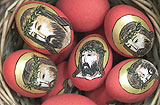 ,并有乐队与圣咏团以哈利路亚及赞美诗歌来庆祝象征耶稣升起的太阳,至今在奥地利阿尔卑斯山区仍保有这种清晨致敬的习俗。
,并有乐队与圣咏团以哈利路亚及赞美诗歌来庆祝象征耶稣升起的太阳,至今在奥地利阿尔卑斯山区仍保有这种清晨致敬的习俗。
斯拉夫民族也保有其古老的复活节习俗,教堂从早到晚都要以短暂的间隔持续敲钟,来提醒信徒这是一年中最伟大的日子之一。
在罗马尼亚,基督徒在上教堂前,会先在家里大扫除,穿新衣,沐浴,这样做是为了表示一个新的开始。在40天的四旬期之后,各家的桌上都充满了各样美食,并以美美的彩蛋来陪衬,增加节庆的气氛。最高兴的莫过于小孩了,因为他们可以在草丛中寻找礼物和彩蛋!
罗马尼亚的农民,会穿著传统的服饰,并点燃手中的蜡烛,在午夜时聚集在教堂周围,装严地喊着:“耶稣已从死里复活了!”在每个教堂的周围,不论是山丘或平原,人们手持着蜡烛,并高声唱着赞美诗。
 收听单词发音
收听单词发音
1
Christian

|
|
| adj.基督教徒的;n.基督教徒 | |
参考例句: |
|
|
|
2
mythology

|
|
| n.神话,神话学,神话集 | |
参考例句: |
|
|
|
3
derived

|
|
| vi.起源;由来;衍生;导出v.得到( derive的过去式和过去分词 );(从…中)得到获得;源于;(从…中)提取 | |
参考例句: |
|
|
|
4
dedicated

|
|
| adj.一心一意的;献身的;热诚的 | |
参考例句: |
|
|
|
5
celebrated

|
|
| adj.有名的,声誉卓著的 | |
参考例句: |
|
|
|
6
Christians

|
|
| n.基督教徒( Christian的名词复数 ) | |
参考例句: |
|
|
|
7
decided

|
|
| adj.决定了的,坚决的;明显的,明确的 | |
参考例句: |
|
|
|
8
pointed

|
|
| adj.尖的,直截了当的 | |
参考例句: |
|
|
|
9
commemorates

|
|
| n.纪念,庆祝( commemorate的名词复数 )v.纪念,庆祝( commemorate的第三人称单数 ) | |
参考例句: |
|
|
|
10
bondage

|
|
| n.奴役,束缚 | |
参考例句: |
|
|
|
11
blasphemy

|
|
| n.亵渎,渎神 | |
参考例句: |
|
|
|
12
advent

|
|
| n.(重要事件等的)到来,来临 | |
参考例句: |
|
|
|
13
foretold

|
|
| v.预言,预示( foretell的过去式和过去分词 ) | |
参考例句: |
|
|
|
14
equanimous

|
|
| adj.安静的,镇定的 | |
参考例句: |
|
|
|
15
devoted

|
|
| adj.忠诚的,忠实的,热心的,献身于...的 | |
参考例句: |
|
|
|
16
rites

|
|
| 仪式,典礼( rite的名词复数 ) | |
参考例句: |
|
|
|
17
forefathers

|
|
| n.祖先,先人;祖先,祖宗( forefather的名词复数 );列祖列宗;前人 | |
参考例句: |
|
|
|
18
glorification

|
|
| n.赞颂 | |
参考例句: |
|
|
|
19
banishing

|
|
| v.放逐,驱逐( banish的现在分词 ) | |
参考例句: |
|
|
|
20
noted

|
|
| adj.著名的,知名的 | |
参考例句: |
|
|
|
21
astronomical

|
|
| adj.天文学的,(数字)极大的 | |
参考例句: |
|
|
|
22
penitence

|
|
| n.忏悔,赎罪;悔过 | |
参考例句: |
|
|
|
23
joyous

|
|
| adj.充满快乐的;令人高兴的 | |
参考例句: |
|
|
|
24
secular

|
|
| n.牧师,凡人;adj.世俗的,现世的,不朽的 | |
参考例句: |
|
|
|
25
icons

|
|
| n.偶像( icon的名词复数 );(计算机屏幕上表示命令、程序的)符号,图像 | |
参考例句: |
|
|
|
26
emblem

|
|
| n.象征,标志;徽章 | |
参考例句: |
|
|
|
27
missionaries

|
|
| n.传教士( missionary的名词复数 ) | |
参考例句: |
|
|
|
28
knights

|
|
| 骑士; (中古时代的)武士( knight的名词复数 ); 骑士; 爵士; (国际象棋中)马 | |
参考例句: |
|
|
|
29
superstition

|
|
| n.迷信,迷信行为 | |
参考例句: |
|
|
|
30
blessings

|
|
| n.(上帝的)祝福( blessing的名词复数 );好事;福分;因祸得福 | |
参考例句: |
|
|
|
31
prolific

|
|
| adj.丰富的,大量的;多产的,富有创造力的 | |
参考例句: |
|
|
|
32
trumpet

|
|
| n.喇叭,喇叭声;v.吹喇叭,吹嘘 | |
参考例句: |
|
|
|
33
florists

|
|
| n.花商,花农,花卉研究者( florist的名词复数 ) | |
参考例句: |
|
|
|
34
proceeding

|
|
| n.行动,进行,(pl.)会议录,学报 | |
参考例句: |
|
|
|
35
commentators

|
|
| n.评论员( commentator的名词复数 );时事评论员;注释者;实况广播员 | |
参考例句: |
|
|
|
36
lighting

|
|
| n.照明,光线的明暗,舞台灯光 | |
参考例句: |
|
|
|

















